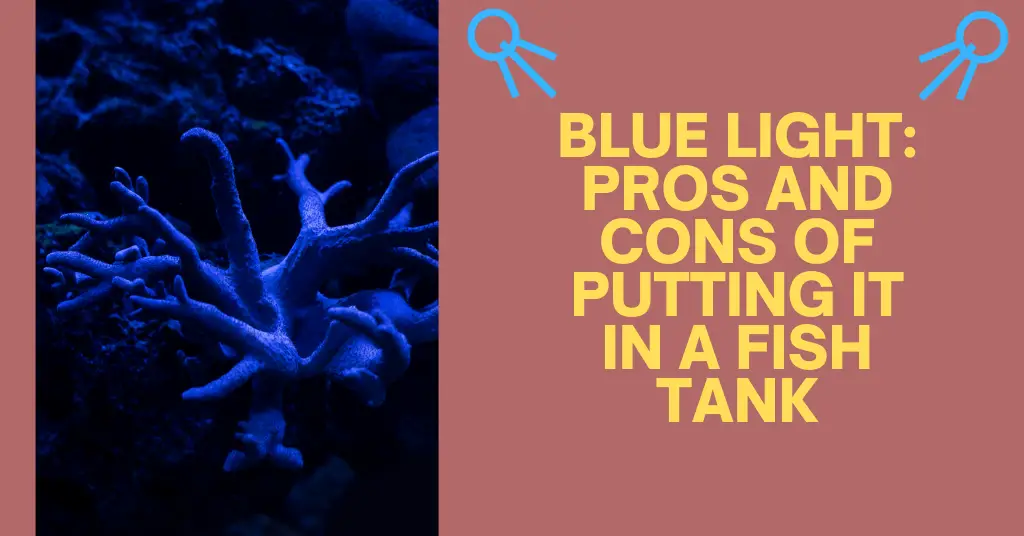Last Updated on July 4, 2021 by cmoarz
The lighting you use in an aquarium is an important aspect of the aquarium hobby. You might have noticed a trend of people using blue light in their aquarium and might be wondering why that is. What does blue light in a fish tank do? We’re going to answer that for you and more.

What does blue light in a fish tank do?
Table of Contents
Blue light in your aquarium does more than looking good, It provides a mellow moonlight emulation that allows your agitated fish to calm down, and your nocturnal fish to feel like they can move out and about without being hunted. It provides a wonderful transition from light to dark, and it does look good!
Emulating nighttime light is super important for certain fish. This can be achieved by various types of lights, (compact fluorescent bulbs, metal halide, etc) but most commonly used these days are LEDs.
This is because of the significant reduction in heat output and electricity input. I don’t need to explain to you what that means for your electric bill!
The Pros and Cons of Putting a blue light in a fish tank
The Pros
1. Blue light helps to calm agitated fish by providing them with moonlight that mimics what they would see at nighttime in nature.
2. It provides a mellow transition from daytime to nighttime, which is important for certain nocturnal fishes or for those who are easily startled by changes in lighting.
3. It looks great when it’s on! The soothing blue hue can be quite beautiful and make your aquarium stand out from the rest.
4. Less heat output than other types of lights means you’ll save money on electricity bills (this goes for any light, be it night or blue night light that uses LED’s rather than fluorescent bulbs or metal halide bulbs).
5. You won’t have to worry about eyeshine as much because there isn’t as much brightness.
6. It lowers the overall stress levels in the fish. Especially coupled with a timer circuit and dimmer switch.
The Cons
• As with any type of light, blue or otherwise, there is a potential to over-expose your fish which can lead to diseases and health problems.
• Over time the intensity of the light will decrease due to things like dust buildup and weakening bulbs.
• Blue lights may be aesthetically pleasing but they are not natural for a typical underwater environment. They can disrupt natural feeding behavior and have been linked to stress-related behavior in larger predatory species such as sharks and barracudas. (Although the average reader of this article is not likely to have these!)
How Long Should You Leave the Light on in a Fish Tank?
The amount of time you should leave the light on in your fish tank depends largely on what type of lighting you are using and what species it is for.
It’s important to note that some types (such as metal halide, compact fluorescent) have a higher heat output than others which can result in serious burns if not monitored closely by turning off after the allotted time or being covered with an appropriate fixture.
The day and night cycle for a fish is the same as a human, and while not all fish sleep schedules are the same, we all share the same sunlight that sets at a certain time and rises at a certain time.
It’s important for aquarium owners to understand the day and night cycle of their fish. This is particularly true if you’re considering using moonlight to calm them in your tank.
Once you know the cycle you should be using, consider adding a timer and switch to the daylight and the blue light for automated switching.
Should I Turn My Fish Aquarium Light Off at Night or use Blue light instead?
There is no definitive answer to this question but there are many opinions!
Some people say they should turn the light off and let their fish be bathed in what natural moonlight there is. Others feel like it’s a necessity to provide some sort of simulated nighttime environment with blue LED lights or other types of lighting.
At the end of the day, You definitely shouldn’t leave the normal light on at night, and whether you use blue light for no-light at night alternative is a personal choice. I will refer you to the pros and cons list above in this article to help you make the choice that’s right for your fish.
Bottom line
Blue light is a great option for those who want to create an aesthetically pleasing tank that mimics natural conditions. However, it’s important to remember the pros and cons of blue lights as well as other types of lighting when considering how best to provide nighttime illumination in your fish tank. Before you make any decisions about what type or color of light you should use at night, be sure you’ve considered these factors carefully so that all aspects are taken into account!
Some related question
Can I leave blue light on in fish tank all the time?
No. It’s important to keep an eye on what type of light you use and how long it is left on so that your fish can have the best environment possible. All fish aside from ones who dwell deep in the depths of the ocean requires some amount of regular light. Having a blue light on 24/7 will not give them the proper wavelengths of necessary usable light.
What color light is best for fish tank?
There are pros and cons to every type of light. You’ll want to consider what the specific needs of your fish are before making a decision about what color you should use or what spectrum is best for them.
You should find a good balance between spectrum vs intensity. I do recommend full spectrum lights during the day.
Does blue light cause algae in fish tank?
No. Algae is caused by different environmental factors, not what color of light you’re using in your aquarium.
About
Owner of AquariumGravel.com and also owner of actual Aquarium Gravel believe it or not! ;). Setting up beautiful aquarium sceneries and habitats since I was very young. Enjoy!
- Web |
- More Posts(290)

